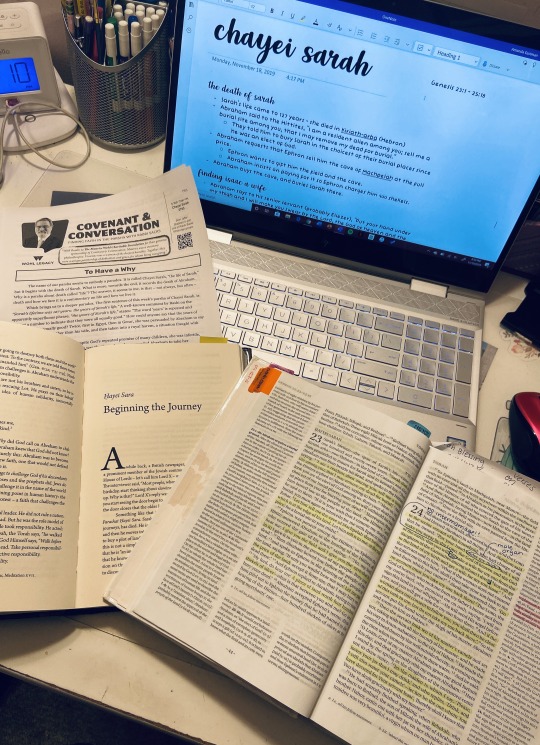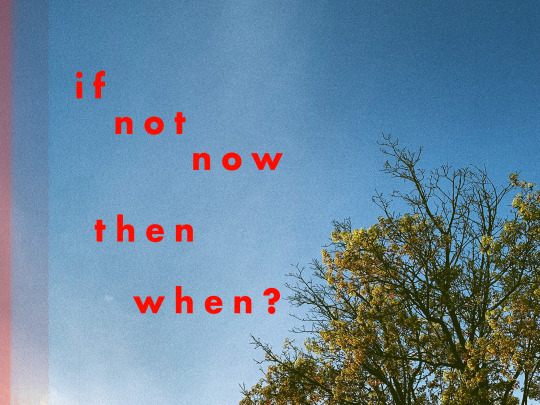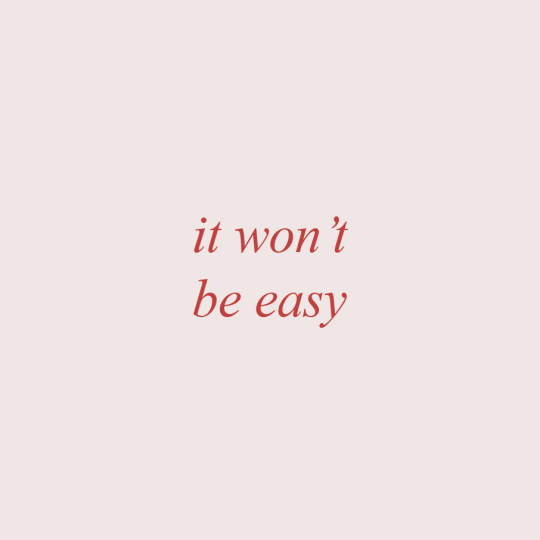Text
“Express empathy whenever you can, to whomever you can. The world needs more souls that hug.”
— juansen dizon
3K notes
·
View notes
Text
Recovery is messy when you're doing it right. 💙

31K notes
·
View notes
Photo

Long time no post!
This week’s Torah portion is Chayei Sarah. In this portion our beloved Sarah dies, Abraham buys the cave of Machpelah to bury her in, a servant finds Rebecca as a wife for Isaac, and Abraham dies. Lots of happenings!
In addition to reading the week’s portion in my Jewish Study Bible (JPS translation), I like to read some commentaries. I read a chapter of Lessons in Leadership by Rabbi Jonathan Sacks every week. Each chapter is only a few pages and offers a lesson on how to be a good leader. Rabbi Sacks points out both the good and bad qualities of our biblical ancestors and turns them into lessons on how we should act. It’s a very easy read and very informative!
I also read Rabbi Sacks’ Covenant and Conversation every week and listen to its accompanying podcast. I have found them to be particularly inspirational and engaging. I highly recommend checking out Covenant and Conversation!
Other podcasts that comment on the weekly parsha that I recommend are On the Other Hand (10 Minutes of Torah with Rabbi Rick Jacobs of the Union for Reform Judaism), Pardes from Jerusalem, and JTS Torah Commentary. These podcasts provide a spectrum of outlooks - ranging from Reform to Orthodox. They are all very interesting and usually don’t provide the same lessons - so you learn a lot!
In addition to all of this, I also like to look in the local Jewish newspaper for the week’s d’var Torah, listen to my rabbi’s sermon for the week, and attend Torah Study at my synagogue (although at Torah Study we read the Torah chronologically, we do not focus on the week’s Torah portion, we just continue where we left off).
It’s really great to get information from a wide variety of sources and outlets. Even better is discussing it with others! I am SO open to having a chevrutah with someone on here. If you are interested please do not hesitate to reach out to me!
16 notes
·
View notes
Text


Finals weeks this week so have to be a bit more organised! New bullet journal spread and some tea while I study for my history final later today
5K notes
·
View notes
Text

After the exciting holiday season, I finally got to go back to my Hebrew class (Ulpan)!! We finished up the first chapter of our book and are moving on to more challenging material next week!
I took two semesters of college Hebrew during my time in undergrad and I never felt the same confidence in those classes as I do in this class. The teacher is very supportive and answers all questions we have.
To help reinforce my learning (since this class is only once a week) I use Duolingo. I am currently on an 8 day streak and hope to keep it up so I can keep learning and growing! Duolingo is an app that I 100% recommend if you’re trying to learn a new language. You can also use their sister app, Tiny Cards, to reinforce vocabulary through digital flash cards.
Can’t wait to learn even more Hebrew!
3 notes
·
View notes
Text
Instead of saying “I don’t deserve ______”, try saying “I am grateful for ______.”
Even if you don’t truly believe that you deserve it or you don’t feel that grateful for it, just switching the negative statement to a positive one can make a huge difference.
You do deserve love. You do deserve happiness. You do deserve recovery. Adding a little bit of gratitude to your day is one of the best things you can do for yourself.
4K notes
·
View notes
Text

I completed my first weekly parsha reading of the new year!
This week we read Bereshit (pronounced burr-ay-sheet), the first portion of the entire Torah and the Hebrew name of the book of Genesis. It includes the two stories of creation - the very short, “and there was ... and there was ... the ... day” type and the Adam and Eve story. It goes on to mention the murder of Abel by Cain, and some details of Adam’s family tree.
I also listened to a fascinating podcast by Rabbi Lord Jonathan Sacks on Bereshit that talks about the duality of the two stories of creation and how their differences provide significant meaning. Here’s a link to that podcast: http://rabbisacks.org/bereishit-5780/
I feel so much more fulfilled and knowledgeable and it’s only week one!
If you want to talk about any portion and have some chevrutah (study buddy) situation please message me!
0 notes
Text
I WILL!
I will heal.
I will move on.
I will love myself.
I will manifest my dreams.
I will enjoy my own company.
I will release my negativity and grow.
I will be me, kind, open, honest, loving.
I will not give up on the woman I’m becoming.
1K notes
·
View notes
Text
“The test of faith is whether I can make space for difference. Can I recognize God’s image in someone who is not in my image, whose language, faith, ideals, are different from mine? If I cannot, then I have made God in my image instead of allowing him to remake me in his.”
— Rabbi LordJonathan Sacks
3K notes
·
View notes
Text
Currently reading this book, and loving it!
“For a thousand years the scapegoat of choice in Europe and the Middle East has been the Jews. They were the most conspicuous outsiders: non-Christian in a Christian Europe, non-Muslim outsiders in an Islamic Middle East. But this chapter is not primarily about antisemitism. It is about what gives rise to it. Antisemitism is only contingently about Jews. Jews are its victims but they are not its cause. The cause is conflict within a culture. It is the potential internal violence that, if expressed, has the power to destroy a society. Recall Girard’s point: the scapegoat is the mechanism by which a society deflects violence away from itself by focusing it on an external victim. Hence, wherever you find obsessive, irrational, murderous antisemitism, there you will find a culture so internally split and fractured that if its members stopped killing Jews they would start killing one another. That is what happened in Europe in the seventeenth century and again in two world wars in the twentieth, and what is happening today in Syria, Iraq, Afghanistan and other war-torn regions in the Middle East, Africa, and Asia. To understand the emergence of the Jew-as-scapegoat we must focus on certain key historic moments. The first is 1095 when Pope Urban II delivered his historic call for the First Crusade. In 1096 some of the Crusaders, on their way to liberate the holy city of Jerusalem, paused to massacre Jewish communities in northern Europe: in Cologne, Worms, and Mainz. Thousands died. Many Jews committed suicide rather than be seized by the mob and forcibly converted to Christianity. It was a traumatizing moment for European Jewry, and the portent of worse to come. From this point onwards Jews in Christian Europe began to be seen by many not as human beings at all but as a malevolent force, as an evil presence, a demonic and destructive power that mysteriously yet actively sought the harm of others. Jews were accused of desecrating the host, poisoning wells and spreading the plague. They were held responsible for the Black Death, the epidemic that in the fourteenth century cost many millions of lives. It was an age in which Jews lived in fear. That period added to the vocabulary of the West such ideas as public disputation, book burning, forced conversion, Inquisition, auto-da-fé, expulsion, ghetto and pogrom. In duration and intensity it ranks among one of the most sustained chronicles of hatred in history… …Eventually Europe moved on, but not before two events that were to have significant consequences centuries later. The first took place in Spain, where, under threat of persecution, Jews had been living in fear from 1391, Spain’s Kristallnacht when synagogues were burned and Jews massacred, until their expulsion in 1492. Many, under threat, had converted. Some were suspected of maintaining Jewish practice in private and became victims of the Inquisition. Others, though, embraced the new faith and achieved positions of prominence in Spanish society. It was then that a new phenomenon appeared: the persistence of prejudice after its overt cause had been removed. The ‘new’ Christians were still hated by some, now not for their religion but for their race. Legislation was introduced to protect Limpieza de sangre, 'purity of blood’. The first such statue appeared in Toledo in 1449. Originally opposed by the Church, it received the approval of Pope Alexander VI in 1496 and lasted well into the nineteenth century. It was the first appearance in history of the racial antisemitism that would flow through mainland Europe four and a half centuries later. The second significant development was Martin Luther. Initially favorably disposed to Jews, he believed that the reason they had not converted was the ineptitude and cruelty of the Catholic Church. Approached with love, he thought they would become Christians en masse. When they did not, his anger knew almost no bounds. In 1543 he published a pamphlet entitled On the Jews and their Lies that became a classic in the literature of hate. Synagogues should be burned. Jewish homes should be destroyed. Jews should be made to live in a single room or stable to know that they were no more than 'miserable captives’. Their prayer books and Talmuds should be confiscated and their rabbis forbidden to teach. They should be forbidden to travel and given no legal protection until the world was rid of what he called 'our plague, pestilence, and misfortune’. The pamphlet was reprinted several times during the Nazi era, and its suggestions paralleled by the Nuremberg laws. Luther’s outburst ensured that hostility to the Jews would persist after the Reformation, and it left a lasting impression in countries where Lutheranism held sway. The striking Christian exception was John Calvin, who held the Hebrew Bible in high regard and was less inclined than most to denigrate the Jews. This had a lasting effect on Holland in the sixteenth century and England in the seventeenth, as well as on the Pilgrim Fathers in America. These were among the first places to develop religious liberty. It is at this point that the story takes a remarkable and tragic twist. Western Europe in the eighteenth century turned to the Enlightenment in the belief that reason could overcome the prejudices of the past. In the nineteenth century this was followed by Emancipation, through which minority religious groups, among them the Jews, were granted civil rights in the new nation states, held together not as in the past by religion but by citizenship and civil law. Yet prejudice persisted, as it had done in post-expulsion Spain. Among its practitioners were some of Europe’s leading minds. Voltaire called Jews 'an ignorant and barbarous people, who have long united the most sordid avarice with the most detestable superstition and the most invincible hatred for every people by who they are tolerated and enriched.’ He added, generously, 'Still, we ought not to burn them.’ Immanuel Kant spoke of Jews as 'the vampires of society’, and called for 'the euthanasia of Judaism’. Georg Hegel saw Jews and Judaism as paradigms of a 'slave morality’, unable to conceive or practice a religion of love. By rejecting Christianity, Jews had been stranded by history and were left as a 'fossil nation’, a 'ghost-race’… …Friedrich Nietzsche castigated Judaism as the 'falsification’ of all natural values. His great originality is that, instead of criticizing Jews for rejecting Christianity, he blamed them for having given birth to it in the first place. Anyone who blames religion for creating hate should consider these examples…philosophical antisemitism from Voltaire to Heidegger is a little-known phenomenon but a devastating one. As European culture became secularized and religious anti-Judaism mutated into racial antisemitism, the consequences were lethal. Christians could work for the conversion of the Jews, because you can change your religion. But you cannot change your blood or your genes. Antisemites could therefore only work for the elimination of the Jews. The result was the Holocaust.”
— Not in God’s Name: Confronting Religious Violence, the Rabbi Lord Jonathan Sacks. New York: Penguin Random House LLC, 2015. (p. 76-80).
2K notes
·
View notes
Text

Last night I created a Bible Study Tracker in my bullet journal! While Jews don’t necessarily call it “The Bible” (we fall it the Tanakh), that’s really what it is! Not just Torah, but also Prophets and Writings.
Each “book” has a set of squares for the sections in it. For example, Genesis (also labeled in the Hebrew, בראשית) has 12 squares to color in - one for each portion in that book.
I have a tracker in my binder I’m using to keep my Bible notes, but this little tracker will be able to travel with me. It’s also SUPER cute! Seeing my progress will help keep me motivated to keep going!
I am using a dot grid journal from Piccadilly, and I love it! For this spread I used washi tape I picked up from Joann Fabrics for super cheap, my Stabilo Pen 68 in gray, an Artist’s Loft illustration pen in 0.3, a blue Mildliner, and black Sharpie!
The quote from Micah was found on Google, and I just printed it out and glued it in!
#bible reading#jewish#torah study#torah#tanakh#rabbi sacks#prophet#bullet journal#stabilo#mildliners
7 notes
·
View notes
Photo

Free Study Planning Printable Pages!
Here are several worksheets to help you better plan, prepare and complete your studies! The page of 10 pages includes daily, weekly and monthly study planners, pages to help track and monitor your studies, and sheets to evaluate how that studying is going. The download links are below:
Monday start set download link
Sunday start set download link
Here are examples and instructions on how to use each page.
You can see other free printables here :-) The ‘Priority Break Down’ sheet is inspired and explained here.
I hope you enjoy using and customising these printables! If you upload a photo featuring it, I’d love to see. Please tag me on Tumblr with #emmastudies or on Instagram with @emmastudiess. You can see other people using my printables by visiting the #esprintables tag on my blog! Please remember, these printables are for personal use only and should not be redistributed as your own.
If you want to find more organisational printables and support me, please check out my Etsy shop with lots of downloads dedicated to students. You can use ‘student10′ to get 10% off any purchase! :-)
Other posts | Printables | Instagram | Youtube | Pinterest | Etsy Shop | Ko-fi
8K notes
·
View notes
Photo

Free DIY Flashcards Printable Pack
I’ve been meaning to organise these for aaaages but thought I’d finally spend the time on them :-) These flashcards are DIY - so you double-side print them so they line up, then cut them out to use! If you struggle to align them you can stick two pages together instead. You can also scale them up or down to bigger or smaller sizes. I also added in some front covers to help organise them! Hope they’re useful :-)
Free download link is below:
DIY Flashcard folder on Google Drive (also added in dotted versions!)
Other free printables you might like: 2018-19 yearly printables, Back to School Student Pack, 2018 Monthly Printables, Weekly Study Schedule, Week at a Glance, Exam Pack, and Notetaking Printables :-)
I hope you enjoy using and customising these printables! If you upload a photo featuring it, I’d love to see. Please tag me on Tumblr with #emmastudies or on Instagram with @emmastudiess. You can see other people using my printables by visiting the #esprintables tag on my blog!
If you want to find more organisational printables and support me, please check out my Etsy shop with lots of downloads dedicated to students. You can use ‘student10′ to get 10% off any purchase! :-)
Other posts | Printables | Instagram | Youtube | Pinterest | Etsy Shop
2K notes
·
View notes




